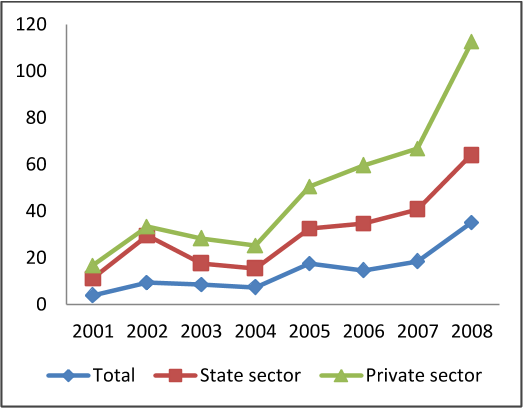




Did you find this useful? Give us your feedback










104 citations
56 citations
...However, at difference of current studies in emerging economies (Armanios et al. 2016; Bastos et al. 2014; Kruss and Visser 2017; Santarelli and Tran 2016) that continue pay attention on those emerging economies’ negative conditions (obstacles, dilemmas and challenges) that limited university–enterprise partnerships, this paper tried to contribute on the debate about the contribution of universities in the radical innovation process of enterprises motivated by a direct enterprises interest for strategic purposes as well as by an indirect enterprises interest of covering the government requirements for accessing to R&D subsidies....
[...]
...2016), the partnership intensity influenced by the technological change and expected profitability translation of innovative effort in Vietnam (Santarelli and Tran 2016), the elements like reputation and national priorities that defined the incentives that drives innovation partnerships in South African (Kruss and Visser 2017)....
[...]
...…et al. 2016), the partnership intensity influenced by the technological change and expected profitability translation of innovative effort in Vietnam (Santarelli and Tran 2016), the elements like reputation and national priorities that defined the incentives that drives innovation partnerships in…...
[...]
...Current researches in the field are paying more attention on university–enterprise partnership across emerging economies providing interesting insights concerning dilemmas experimented in university–enterprise partnership for innovation purposes in Brazil (Bastos et al. 2014), exploring the role of intermediaries in the innovation process in China (Armanios et al. 2016), the partnership intensity influenced by the technological change and expected profitability translation of innovative effort in Vietnam (Santarelli and Tran 2016), the elements like reputation and national priorities that defined the incentives that drives innovation partnerships in South African (Kruss and Visser 2017)....
[...]
...However, at difference of current studies in emerging economies (Armanios et al. 2016; Bastos et al. 2014; Kruss and Visser 2017; Santarelli and Tran 2016) that continue pay attention on those emerging economies’ negative conditions (obstacles, dilemmas and challenges) that limited…...
[...]
45 citations
34 citations
15 citations
816 citations
...Skilled technical workers compared with their unskilled counterparts are more capable to deal with the complexity of innovation (Song et al., 2003), more likely to absorb knowledge and consequently reinforce the absorptive capacity of a given organization (Cohen and Levinthal, 1990), and more…...
[...]
...Skilled technical workers compared with their unskilled counterparts are more capable to deal with the complexity of innovation (Song et al., 2003), more likely to absorb knowledge and consequently reinforce the absorptive capacity of a given organization (Cohen and Levinthal, 1990), and more successful in exploiting innovative ideas....
[...]
816 citations
810 citations
808 citations
...may show a propensity to perform R&D not less significant than that of large firms (Audretsch, 1995)....
[...]
...Technical resources have been widely recognized to be measured through indicators of R&D inputs, R&D processes, and R&D outputs (Audretsch, 1995)....
[...]
...Although the idea of R&D cost spreading supports the advantage of large firms in R&D (Cohen and Klepper, 1996), new technology-based firms (NTBFs) 2 using highly skilled workers may show a propensity to perform R&D not less significant than that of large firms (Audretsch, 1995)....
[...]
692 citations
...Independent variables R&D intensity/Innovation investment rate: Aghion and Howitt (1998) define R&D intensity as the proper measure of the R&D input in the innovation production function....
[...]